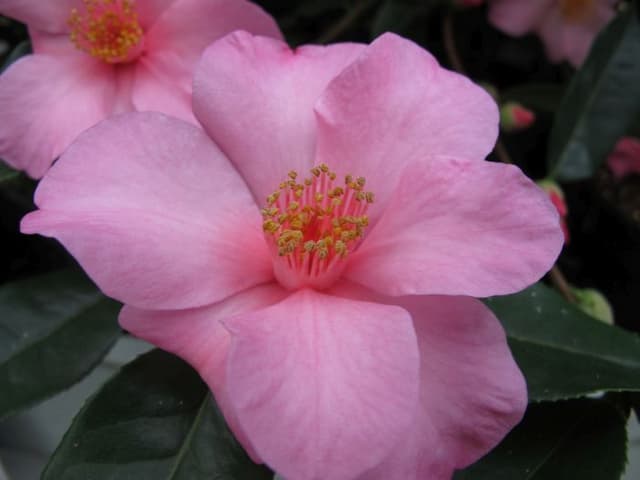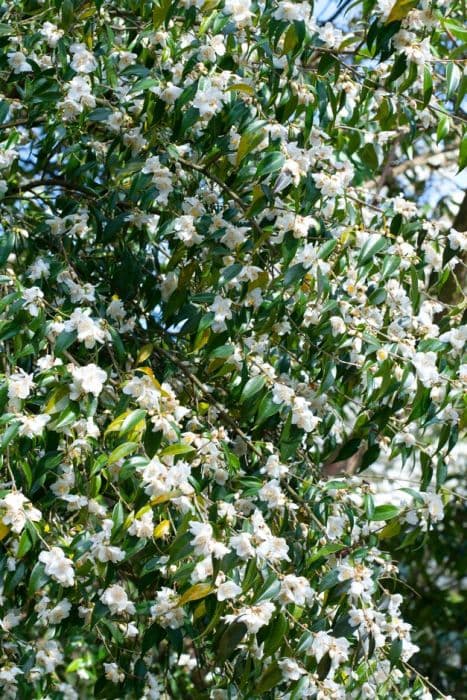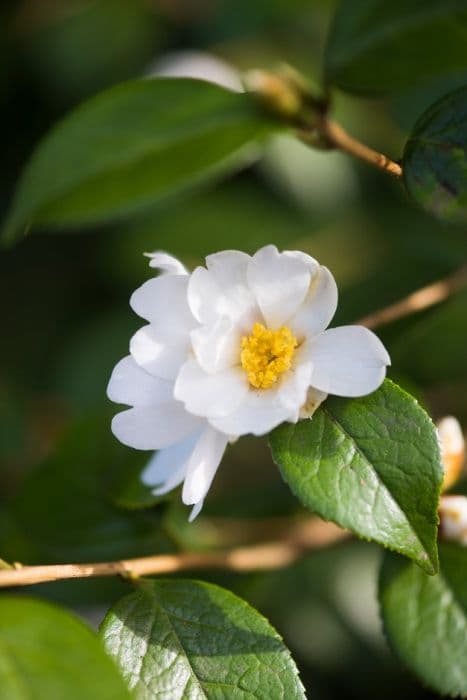Williamsii Camellia Camellia × williamsii 'Mary Christian'

ABOUT
The Camellia 'Mary Christian' is a flowering plant notable for its exquisite blooms and lush, evergreen foliage. The flowers of 'Mary Christian' are delicate and somewhat smaller compared to other varieties, often displaying a two-tone effect. They present a mix of blush pink and white, with the outer petals typically a soft pink while the inner petals may be a lighter shade or white, creating a stunning contrast. Each flower comprises multiple petals that are subtly ruffled and arranged in a classic, formal double pattern, which gives the bloom a very full and densely arranged appearance. Leaves on the Camellia 'Mary Christian' are glossy and dark green, forming a striking backdrop to showcase the flowers. The leaves are typically oval-shaped with slightly serrated edges. They are also leathery in texture, which allows them to withstand various weather conditions. The plant boasts an upright and bushy form, often contributing to a sense of density in landscaping design. The foliage remains attractive throughout the year, making it a valuable plant for year-round interest. As a flowering shrub, the Camellia 'Mary Christian' is prized for its ornamental beauty. Despite the omission of specific size descriptions, it is important to note that the overall appearance of the plant can vary based on growing conditions and care. The delicate beauty of the blossoms and the robust nature of the foliage make it a favorite among gardeners seeking to add a touch of elegance to their garden spaces. Blooming typically occurs in the cooler months, which serves to brighten gardens when most other plants have ceased blooming.
About this plant
 Names
NamesFamily
Theaceae
Synonyms
Williams' Camellia, Hybrid Camellia
Common names
Camellia × williamsii 'Mary Christian'.
 Toxicity
ToxicityTo humans
Camellia 'Mary Christian' is not known to be toxic to humans. There are no significant toxicity reports regarding ingestion of any parts of the plant by humans, and it is generally considered safe. Consequently, there are no documented symptoms of poisoning from this plant for humans.
To pets
Camellia 'Mary Christian' is also not known to be toxic to pets. It is generally considered non-toxic for animals such as dogs and cats. Therefore, ingestion of this plant's parts should not lead to poisoning or cause harmful symptoms to pets.
 Characteristics
CharacteristicsLife cycle
Perennials
Foliage type
Evergreen
Color of leaves
Green
Flower color
Pink
Height
6-8 feet (1.8-2.4 meters)
Spread
5-7 feet (1.5-2.1 meters)
Plant type
Shrub
Hardiness zones
7-9
Native area
East Asia
Benefits
 General Benefits
General Benefits- Ornamental Value: Camellia 'Mary Christian' is valued for its beautiful flowers and glossy green foliage, which provide aesthetic appeal to gardens and landscapes.
- Extended Blooming Season: This variety often enjoys a longer blooming period than many other plants, offering flowers from fall to spring in suitable climates.
- Shade Tolerance: It can thrive in partially shaded areas where other flowering plants may not perform as well.
- Privacy Screening: With its dense growth habit, it can serve as a natural privacy screen or hedge.
- Low Maintenance: Once established, Camellia 'Mary Christian' requires relatively little care, making it ideal for gardeners of all skill levels.
- Wildlife Attraction: The flowers can attract pollinators such as bees, providing ecological benefits to the garden environment.
 Medical Properties
Medical PropertiesThis plant is not used for medical purposes.
 Air-purifying Qualities
Air-purifying QualitiesThis plant is not specifically known for air purifying qualities.
 Other Uses
Other Uses- Container Plant: Camellia 'Mary Christian' can be planted in a container and placed on patios or balconies for ornamental purposes.
- Topiary or Bonsai: With appropriate pruning techniques, Camellia 'Mary Christian' can be trained into interesting topiary or bonsai shapes.
- Decorative Mulch: The fallen petals of Camellia 'Mary Christian' can be used as a colorful and aromatic mulch in garden beds.
- Holiday Decorations: The flowers and glossy green leaves can be used to create festive wreaths and garlands during the holiday season.
- Photography Backdrop: The plant provides an attractive backdrop for outdoor photography, especially when in bloom.
- Fabric Dyeing: Petals of Camellia 'Mary Christian' can be used to create natural dyes for fabrics, offering gentle hues of pink and red.
- Ink Making: The petals may also be boiled down to produce colored ink for art projects or traditional calligraphy.
- Artistic Inspiration: The blooms of Camellia 'Mary Christian' are often used as subjects in botanical art and watercolor paintings.
- Educational Tool: Horticulture students can use Camellia 'Mary Christian' to learn about crossbreeding and the characteristics of hybrid plants.
- Wedding Décor: The blooms can be used for table centerpieces or as decoration on wedding cakes, offering romance and elegance to the celebrations.
Interesting Facts
 Feng Shui
Feng ShuiThe Camellia is not used in Feng Shui practice.
 Zodiac Sign Compitability
Zodiac Sign CompitabilityThe Camellia is not used in astrology practice.
 Plant Symbolism
Plant Symbolism- Admiration: Camellias often represent admiration and deep respect due to their exquisite beauty, and the Camellia 'Mary Christian' inheriting this symbolism is a fitting tribute to admire someone's grace and dignity.
- Perfection: With its perfect form and vibrant, flawless blooms, a Camellia 'Mary Christian' signifies the pursuit of perfection and excellence, making it an ideal gift for someone who strives for these qualities.
- Affection: The warm and cozy feeling emanating from the Camellia 'Mary Christian's' colorful petals symbolizes a genuine affection towards another person.
- Long-lasting Loyalty: Much like the enduring nature of its evergreen leaves, the Camellia 'Mary Christian' represents steadfast loyalty and an everlasting bond between people.
- Inherent Worth: A reminder of one's intrinsic value and self-esteem, the Camellia 'Mary Christian' symbolizes the acknowledgment of personal worth and beauty both inside and out.
 Water
WaterThe Williamsii Camellia requires consistent moisture; water the plant deeply to ensure the soil is moist but not saturated. Ideally, water the plant with about 1 inch of water each week, but this may need to increase to 1.5 inches during periods of drought or very hot weather. During the winter, reduce the amount of water slightly, but do not allow the soil to dry out completely. It's essential to water the plant at its base and avoid wetting the foliage to prevent fungal diseases. If container-grown, ensure that excess water can drain freely to prevent root rot.
 Light
LightWilliamsii Camellias thrive in partial shade; they prefer a location that provides morning light and is protected from the intense afternoon sun. An ideal spot might be under the high, dappled shade of taller trees where they can receive bright indirect light. They can also adapt to growing in deeper shade, which makes them suitable for north-facing gardens or the east side of a building where they can get some morning light without the risk of sunburn.
 Temperature
TemperatureWilliamsii Camellias prefer moderate temperature conditions, ideally between 60 and 75 degrees Fahrenheit. They can withstand minimum temperatures down to about 10 degrees Fahrenheit, but prolonged exposure to cold below 20 degrees can damage the plant. Similarly, prolonged high temperatures over 85 degrees Fahrenheit, especially combined with dry conditions, can be stressful for the plant.
 Pruning
PruningPrune your Williamsii Camellia to maintain shape and promote airflow, which can minimize disease risk, after it finishes flowering in the spring. Thin out dense branches and remove any dead or weak wood. Pruning is also a good time to reduce the size of the plant if needed. Be careful not to over-prune, as this can reduce flowering the following season.
 Cleaning
CleaningAs needed
 Soil
SoilWilliamsii Camellias prefer acidic soils with a pH of 5.5 to 6.5; the best soil mix is well-draining and rich in organic matter. Use a mix comprising of one-third peat moss, one-third pine bark, and one-third perlite or sand to ensure proper drainage and aeration for the roots.
 Repotting
RepottingWilliamsii Camellias should be repotted every 2 to 3 years to refresh the soil and encourage healthy growth. It's best to repot in the spring before the blooming period or in the fall after flowering has ceased.
 Humidity & Misting
Humidity & MistingWilliamsii Camellias thrive in moderate to high humidity levels, ideally between 40-60%. They benefit from the occasional misting if indoor air is dry, but avoid creating overly damp conditions that can lead to fungal issues.
 Suitable locations
Suitable locationsIndoor
Provide bright, indirect light and keep soil moist.
Outdoor
Plant in partial shade, shelter from strong winds.
Hardiness zone
7-9 USDA
 Life cycle
Life cycleCamellia × williamsii 'Mary Christian', commonly known as Williamsii camellia, begins its life cycle as a seed, which, upon germination, establishes a small seedling. The seedling then enters a vegetative stage, during which it develops roots, stems, and leaves. As the plant matures, it progresses to a phase of foliage expansion and stem elongation, eventually reaching maturity where it can support reproduction. The Williamsii camellia typically flowers in late winter to early spring, with blooms ranging from white to pink, a stage which attracts pollinators and marks the beginning of the reproductive cycle. Following pollination, the plant forms seed pods that, once mature, release seeds to begin the next generation. Throughout its life, the camellia will go through cycles of growth and dormancy, adapting to the changing seasons.
 Propogation
PropogationPropogation time
Spring-Early Summer
The most popular method of propagating Camellia × williamsii 'Mary Christian', commonly known as Camellia, is through semi-hardwood cuttings. This is typically done in late summer, when the new growth has matured and begun to harden. Select a healthy stem that is about a quarter of an inch in diameter (around 6 millimeters) and cut a four to six-inch (10 to 15 cm) length just below a leaf node. Remove the lower leaves, leaving just a few at the top, and dip the cut end into a rooting hormone to encourage root development. The cutting should then be placed in a pot filled with a moist mixture of peat and perlite. Covering the pot with a plastic bag or placing it in a greenhouse can create a humid environment conducive to rooting. Keep the soil moist but not waterlogged and wait for several weeks until the cutting has rooted, after which it can be transplanted into a larger pot or into the ground.









